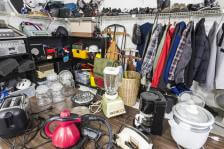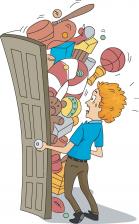13 Surprising Facts About Hoarding
Think of your most valued possession. Your jewelry? That box of precious family photos? Baseball memorabilia? Now, imagine feeling that way about every single item in your house. Welcome to the mindset of hoarding disorder. This week, Savvy Psychologist has 13 surprising facts about hoarding.

You can’t tell for sure without going inside a house or apartment, of course, but there are outward signs that stuff may be overloading a life – the backseat of the car filled to the windows, a yard filled with junk, or constantly carrying around a bunch of overflowing bags “just in case.”
What Is Hoarding?
Put simply, collecting, saving, or being a pack rat crosses the line into hoarding disorder when all those possessions cause distress to the individual or interfere with living a normal life.
Hoarding often makes a home unable to be used as intended, which spirals into wrecking hoarders’ lives in other ways.
For example, because hoarders are usually embarrassed or ashamed to let people into their homes, something as simple as an out-of-reach burned-out light bulb might go unchanged for years. In fact, a 2001 study of hoarders over the age of 60 found that 45% couldn’t use their refrigerator (it was either buried, broken, or filled with non-food stuff), 42% couldn’t use their bathtub, and 10% couldn’t use – or even reach – their toilet. Likewise, there are often legal ramifications, especially if the property is rented, or unsanitary due to animals or trash that is hoarded. And of course, the emotional turmoil of feeling controlled by stuff isn’t to be taken lightly.
Sponsor: Visit GoDaddy.com to get the right domain for your business. Use offer code qdt28 to get 28% off new product orders. Some limitations apply, see website for details.
Follow any case of hoarding back to the roots and you’ll find a complex web of genetics, neurology, and psychology. So let’s go beyond the piles and chaos to paint a more complex picture of hoarders. This week, here are 13 surprising facts you may not know about hoarding disorder:
13 Surprising Facts About Hoarding

Fact #2: As of 2013, hoarding is its own disorder. Hoarding used to be considered a form of OCD, but recent research has exposed important differences. For instance, OCD primarily feels bad – obsessions make one anxious, and compulsions that attempt to relieve that anxiety aren’t necessarily pleasant (a relief, to be sure, but not exactly joyful). Hoarding, by contrast, involves quite a bit of joy. Many people who hoard love the thrill of discovering a treasure for free, the high of buying that perfect item, or the feeling of connection when finding an item to give to a friend. These good feelings are hard to give up and are part of what makes hoarding so hard to treat.
Fact #3: Over one-third of hoarders also have ADHD. Hoarders often have a really hard time making decisions, planning activities, paying attention, and prioritizing. Everything is of equally vital importance, from their passport to that lone chopstick. Sound like ADHD? You’re right – a 2010 study found that over one-third of hoarders also met criteria for an ADHD diagnosis.
Facts #4 and 5: Hoarding runs in families. Also, hoarders are often survivors of trauma or neglect. Hoarding is at least partially genetic, so it’s not uncommon to see siblings or other relatives with the disorder. And many, but not all, hoarders have a trauma or childhood abuse or neglect lurking somewhere in their background. Now, that’s not to say that all hoarders were abused – indeed, traumas from anytime in the lifespan can set it off, and sometimes hoarding arises despite a perfectly peaceful life. But to use a somewhat traumatic analogy, you could say that genetics loads the gun and trauma (often) pulls the trigger.
Fact #6: Hoarders don’t all hoard for the same reasons. Some hoard things they think of as extensions of themselves – personal memorabilia or everyday items from their lives. Others hoard things that remind them of people they love – those 40 jars of mustard turn out to be a sister’s favorite brand. Some hoard things they think are useful or will come in handy one day; even things like rusty nails or discarded wire has a potential use. Still others see themselves as stewards of a certain item, like every New York Times issue since 1968 (even if the ones in the garage are moldy).
Fact #7: Paper hoarding is often about the information. Folks who hoard newspapers, magazines, junk mail, or other papers aren’t necessarily interested in the items themselves; they’re interested in the information printed on that paper. Oftentimes, they don’t even read what’s on the paper – just perceiving they have the information at their fingertips (which will surely come in handy someday) – is the point.
Fact #8: This may seem counterintuitive, but almost all hoarders are perfectionists. Hear me out on this one. Perfectionists see things as black or white – all or nothing. If they can’t do something 110% right, they won’t do it at all. So when they can’t meet their own standards, they give up. Therefore, hoarders would rather live in squalor than risk a less-than-perfect hoard.
But “perfect” might not be what you or I call perfect: those of you with OCD or OCD tendencies might be able to understand this. Sometimes objects have to be arranged so they are “just right.” You just know in your bones when it’s right, and you do it over and over until you feel that “just right” feeling. Then you know it’s perfect. Hoarders might feel, for example, that clothing is only “just right” if it’s just been purchased and never worn, thereby explaining a room full of clothes with the tags still on. Or they may purchase item after item, always looking for the “perfect” gift for friends, even with hundreds of gift bags lining the hallway already.
Fact #9: Hoarders think they have lousy memories. On the contrary, their memory is often completely normal – what’s happening is they don’t trust their memory. They may think they need to keep all their possessions visible in order to remember they have them. Or they may keep papers as a stand-in for remembering the information. It’s as if their brain’s memory is stored externally – inside their home rather than inside their skull.
Fact #10: Hoarders are often quite thoughtful and considerate, picking up items or information they think someone else could use. They also often have tremendous empathy, sometimes anthropomorphizing objects and thinking quite tenderly about the object’s comfort.
Fact #11: Hoarders often have an exquisite sense for color and shape. They perceive the world differently than the rest of us. They may find genuine joy with objects of their favorite color, or find beauty and appreciation in something non-hoarders can’t seem to muster enthusiasm for, like a bag full of colorful twist ties, or that perfect orange milk crate.
Fact #12: Hoarders develop “clutter blindness.” When shown photographs of their homes, many hoarders don’t even recognize their rooms. Something about living in the midst of it causes a kind of “clutter blindness,” perhaps in the same way that people living in big cities eventually don’t notice sirens or taxi horns. But it gets more extreme. When asked to draw a plan of their home, many hoarders don’t remember to account for the space filled with clutter. Sometimes, the existence of a room that’s completely filled may be completely forgotten.
Fact #13: Unfortunately, hoarding is notoriously hard to treat. This is one of those disorders where drugs don’t really work. To my knowledge, there are no successful studies on medication for hoarding. The only thing that has been found to work is cognitive-behavioral therapy with a therapist experienced in treating hoarding, but – and this is a big one – the individual has to want to do something about the problem, which inevitably means getting rid of items, which is often more distressing than just living with the mess. Imagine someone asking you to throw out that one thing you’d take to a desert island. That’s how it feels for a hoarder to face a prospective clean-up.
A helpful fact sheet from the International OCD Foundation, the leading organization for hoarding awareness and research can be found here.
A great book on hoarding, which inspired parts of this episode, is Stuff: Compulsive Hoarding and the Meaning of Things by Randy O. Frost and Gail Steketee, scientists on the cutting edge of hoarding research. It reads like a thriller; in fact, dare I say, it was a compulsive read.
And finally, a novel inspired by history’s most famous hoarders offers a compassionate look at the imagined lives of the Collyer brothers, who died under more than 120 tons of trash in their New York City mansion. It’s entitled Homer & Langley, by none other than E.L. Doctorow.
References
Nordsletten, A.E., Reichenberg, A., Hatch, S.L., Fernandez de la Cruz, L. Pertusa, A., Hotopf, M. et al. (2013). Epidemiology of hoarding disorder. British Journal of Psychiatry, 203, 445-52.
Kim, H., Steketee, G., & Frost, R.O. (2001). Hoarding by elderly people. Health & Social Work, 26, 176-184.
Sheppard, B., Chavira, D., Azzam, A., Grados, M.A., Umana, P., Garrido, H., et al. (2010). ADHD prevalence and association with hoarding behaviors in childhood-onset OCD. Depression and Anxiety, 27, 667-674.
Please note that all content here is strictly for informational purposes only. This content does not substitute any medical advice, and does not replace any medical judgment or reasoning by your own personal health provider. Please always seek a licensed physician in your area regarding all health related questions and issues.
Closet clutter image courtesy of Shutterstock.








